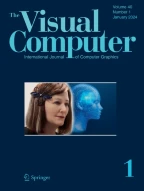Abstract
The social force model (SF) is able to reproduce many emergent phenomena observed in real crowds. Unfortunately, in some situations, such as low density environments, SF may produce counterintuitive results where the trajectories simulated look more like particles than to real people. We modify the SF model through the use of a mobile grid to allow the simulated pedestrians to change the direction of their desired velocity at reasonable times, thus avoiding nearby blocked or crowded areas smoothly. Our experiments focus on qualitative behavior, and verify that our model produces the desired trajectories of the pedestrians, achieving softer and more coherent trajectories when compared to the pure SF model solution. Like SF, our model reproduces the “faster-is-slower” and the arching underlying the clogging effects. Finally, we examine the occupation rates of the space when pedestrians were submitted to narrowed corridors and observe the “edge effect.”
Similar content being viewed by others
Explore related subjects
Discover the latest articles, news and stories from top researchers in related subjects.References
Goldenstein, S., Large, E., Metaxas, D.: Non-linear dynamical system approach to behavior modeling. Vis. Comput. 15(7), 349–364 (1999)
Goldenstein, S., Karavelas, M., Metaxas, D., Guibas, L., Aaron, E., Goswami, A.: Scalable nonlinear dynamical systems for agent steering and crowd simulation. Comput. Graph. 25(6), 983–998 (2001)
Guo, R., Huang, H.: A mobile lattice gas model for simulating pedestrian evacuation. Physica A, Stat. Mech. Appl. 387(2–3), 580–586 (2008)
Helbing, D., Molnár, P.: Social force model for pedestrian dynamics. Phys. Rev. E, Stat. Phys. Plasmas Fluids Relat. Interdiscip. Topics 51(5), 4282–4286 (1995)
Helbing, D., Farkas, I., Vicsek, T.: Simulating dynamical features of escape panic. Nature 407(6803), 487–490 (2000)
Helbing, D., Johansson, A., Al-Abideen, H.: The dynamics of crowd disasters: An empirical study. Phys. Rev. E, Stat. Nonlin. Soft Matter Phys. 75(4) (2007)
Henderson, L.F.: The statistics of crowd fluids. Nature 229(5284), 381–383 (1971)
Huang, L., Wong, S.C., Zhang, M., Shu, C., Lam, W.H.K.: Revisiting Hughes’ dynamic continuum model for pedestrian flow and the development of an efficient solution algorithm. Transp. Res., Part B, Methodol. 43(1), 127–141 (2009)
Hughes, R.L.: A continuum theory for the flow of pedestrians. Transp. Res., Part B, Methodol. 36(6), 507–535 (2002)
Kapadia, M., Singh, S., Hewlett, W., Faloutsos, P.: Egocentric affordance fields in pedestrian steering. In: Proceedings of the 2009 Symposium on Interactive 3D Graphics and Games, pp. 215–223 (2009)
Lerner, A., Fitusi, E., Chrysanthou, Y., Cohen-Or, D.: Fitting behaviors to pedestrian simulations. In: Eurographics Symposium on Computer Animation, pp. 199–208 (2009)
Muramatsu, M., Irie, T., Nagatani, T.: Jamming transition in pedestrian counter flow. Physica A, Stat. Theor. Phys. 267(3–4), 487–498 (1999)
Musse, S., Thalmann, D.: Hierarchical model for real time simulation of virtual human crowds. IEEE Trans. Vis. Comput. Graph. 7, 152–164 (2001)
Musse, S., Jung, C., Jacques, J. Jr., Braun, A.: Using computer vision to simulate the motion of virtual agents: Research articles. Comput. Animat. Virtual Worlds 18(2), 83–93 (2007)
Perez, G.J., Tapang, G., Lim, M., Saloma, C.: Streaming, disruptive interference and power-law behavior in the exit dynamics of confined pedestrians. Physica A, Stat. Mech. Appl. 312(3–4), 609–618 (2002)
Reynolds, C.: Flocks, herds and schools: A distributed behavioral model. SIGGRAPH 21(4), 25–34 (1987)
Shao, W., Terzopoulos, D.: Autonomous pedestrians. In: Eurographics Symposium on Computer Animation, pp. 19–28 (2005)
Singh, S., Kapadia, M., Faloutsos, P., Reinman, G.: Steerbench: A benchmark suite for evaluating steering behaviors. Comput. Animat. Virtual Worlds 20(5–6), 533–548 (2009)
Still, G.: Crowd dynamics. Ph.D. thesis, Mathematics Department, Warwick University (2000)
Tajima, Y., Nagatani, T.: Scaling behavior of crowd flow outside a hall. Physica A, Stat. Mech. Appl. 292(1–4), 545–554 (2001)
Treuille, A., Cooper, S., Popović, Z.: Continuum crowds. In: SIGGRAPH, pp. 1160–1168 (2006)
Tu, X., Terzopoulos, D.: Artificial fishes: Physics, locomotion, perception, behavior. In: SIGGRAPH, pp. 43–50 (1994)
Varas, A., Cornejo, M., Mainemer, D., Toledo, B., Rogan, J., Munoz, V., Valdivia, J.: Cellular automaton model for evacuation process with obstacles. Physica A, Stat. Mech. Appl. 382(2), 631–642 (2007)
Acknowledgements
We would like to thank CNPq, CAPES, and FAPESP for the financial support. We also express our gratitude to Dirk Helbing, Illés Farkas, and Tamás Vicsek for kindly providing us with their source code.
Author information
Authors and Affiliations
Corresponding author
Rights and permissions
About this article
Cite this article
Saboia, P., Goldenstein, S. Crowd simulation: applying mobile grids to the social force model. Vis Comput 28, 1039–1048 (2012). https://doi.org/10.1007/s00371-012-0731-y
Published:
Issue Date:
DOI: https://doi.org/10.1007/s00371-012-0731-y
